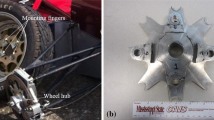Abstract
The right-rear wheel of a full-size pickup truck involved in a single-vehicle accident was alleged to have fractured, leading to loss of vehicle control. The wheel was found fractured and partially separated from the vehicle by a distance of approximately 200 feet from the final resting point of the vehicle. The wheel was manufactured using a common casting procedure utilizing aluminum alloy A356 in the T6 condition. In subsequent litigation, the presence of porosity in the wheel was alleged to have precipitated the failure. Radiographic inspection of the wheel displayed the presence of shrinkage porosity in a quantity less than the maximum allowed according to the part specification. The recovered portions of the right-rear wheel exhibited evidence of impact overload fracture, including significant deformation. Inspection of the remaining artifacts also revealed that the right-front wheel exhibited a similar fracture as the rear.









Similar content being viewed by others
References
M. Warmuzek, Aluminum–Silicon Casting Alloys Atlas of Microfractographs (ASM International, Materials Park, 2004)
National Highway and Traffic Safety Administration (NHTSA). The Pneumatic Tire. US Department of Transportation. DOT HS 810 561, (2006)
ASTM Standard E155, Standard Reference Radiographs for Inspection of Aluminum and Magnesium Castings (ASTM International, West Conshohocken, 2010)
D.A. Lados, D. Apelian, A.M. de Figueredo, Fatigue performance of high integrity cast aluminum components. in Proceedings from the 2nd International Aluminum Casting Technology Symposium, (ASM International, Columbus, 2002)
J.A. Odegard, K. Pedersen, Fatigue properties of an A356 (AlSi7Mg) Alumium alloy for automotive applications- fatigue life predictions. SAE 940811
T.L. Anderson, Fracture Mechanics Fundamentals and Applications, 3rd edn. (CRC Press, Boca Raton, 2005)
A. Kearney, E.L. Rooy, Aluminum Foundry Products, Properties and Selection: Nonferrous Alloys and Special-Purpose Materials, vol. 2 (ASM Handbook, ASM International, Materials Park, 1990), pp. 123–151
J.G. Kaufman, E.L. Rooy, Aluminum Alloy Castings, Properties, Processes, and Applications (ASM International, Materials Park, 2005)
C.M. Soniso, J. Ziese, Fatigue strength and applications of cast aluminum alloys with different degrees of porosity. Int. J. Fatigue 15(2), 75–84 (1993)
SAE J175, Wheels-Impact Test Procedures-Road Vehicles. Surface Vehicle Recommended Practice, (2003)
SAE J2530, Aftermarket Wheels-Passenger Cars and Light Truck-Performance Requirements and Test Procedures. Surface Vehicle Recommended Practice, (2011)
Author information
Authors and Affiliations
Corresponding author
Rights and permissions
About this article
Cite this article
Weishaupt, E.R., Stevenson, M.E. & Sprague, J.K. Overload Fracture of Cast Aluminum Wheel. J Fail. Anal. and Preven. 14, 702–706 (2014). https://doi.org/10.1007/s11668-014-9899-y
Received:
Published:
Issue Date:
DOI: https://doi.org/10.1007/s11668-014-9899-y




